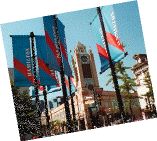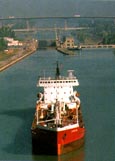Ontario
David Napier
Canada's most populous province is using a combination of
technology and hard work to attract international business -- with great success.
Few symbols have greater international recognition than the mouse with the round black ears and white gloves. That ubiquitous rodent is, of course, Mickey Mouse -- an entertainment icon whose every move draws attention and scrutiny. So when Mickey's parent announced plans to open animation studios in Toronto and Vancouver under the banner of Walt Disney Animation Canada Inc., the expansion made headlines. The American animation giant came north with one thing on its mind: talent.
 |
| William Saunderson, Ontario minister of economic development, trade and tourism, says the automobile industry's brisk activity clearly indicates a healthy economy. |
|
"Canadian animators are recognized worldwide, and we wanted to take advantage of that resource," said Lenora Hume, vice president of international production at Walt Disney Television Animation in California. Hume was referring to the students and graduates of schools such as Sheridan College in Toronto, who will help Walt Disney Animation Canada produce direct-to-home products (such as the sequel to the hit movie Aladdin, titled Return of Jafar, and A Goofy Movie).
Notwithstanding the creative juices that flow in Ontario, the decision to locate in the province made sound economic sense. In addition to a willing and able labor force, the greenback is Popeye-strong in comparison to the Canadian dollar, Ontario's infrastructure is well-equipped to support high-tech branch-plant operations; the business climate is warm, and the quality of life is excellent.
|
Ontario's strong selling features have attracted Disney and countless other international operations. But there is no better barometer of the province's business climate than its automobile industry activity. Manufacturers are hard at work:
|
Ford Motor Co. of Canada Ltd. alone has invested US$3 billion-plus in Canadian plants over the past four years. "Our parent company has always viewed Canada very positively in terms of it being a business location," says company President and CEO Mark Hutchins. "This is evident in our $3.3 billion investment in plant facilities and equipment in Canada since 1992."
One of the biggest announcements in the automotive sector came this February from Toyota Motor Manufacturing Canada Inc.(TMMC) in Cambridge, Ont. Plans were revealed for an all-new, as yet unnamed vehicle to be sold in North America starting in 1998, which will be built exclusively at the Cambridge facility. The retooling includes a substantial increase in the current plant's stamping capabilities -- to seven stamping lines from the current one -- and its first venture into making plastic automotive components. This latest move represents an additional investment of more than US$296 million and will bring Toyota's total commitment at its Cambridge manufacturing operation to more than $1.6 billion.
|
 |
| Ontario Premier Mike Harris has made a commitment to reduce deficit and strategically position the province, differentiating it from other sites. |
|
Toyota's recent announcement comes on the heels of a previous $444 million investment to build a new plant in Cambridge for the production of an additional 120,000 sedans per year. The second plant, adjacent to the first, is nearing completion and will manufacture a new generation of Corollas starting this fall. Total capacity at both plants will increase to 200,000 vehicles annually, from the current 80,000, when the existing plant is retooled to produce the new coupe in 1998. At that time, the number of jobs at TMMC will increase to 2,200 from the current 1,200.
| Courtesy of The Ontario Ministry of Economic Development, Trade and Tourism |
 |
| Ottawa's Peace Tower stands proud in the nation's capital. |
|
Not to be outdone, Honda of Canada Manufacturing (HCM) announced in 1996 that it would invest $219 million into the expansion of its plant in Alliston, Ont. The economic impact of the HCM decision is potentially very great, as indicated by the new auto parts plants that have sprung up to feed the car maker. St. Paris, Ohio-based KTH Parts Industries Inc. laid plans for a $19.4 million, 80-plus employee subsidiary in the town of Shelburne, Ont. Likewise, the picturesque village of Elora, Ont., welcomed the Jefferson Elora Corp., a $17 million, 70-plus employee subsidiary of Jefferson Industries Corp. of West Jefferson, Ohio.
The expanded HCM plant will manufacture V6-powered minivans in addition to the Honda Civic sedans and hatchbacks already produced there.
|
"It's basically a light-truck plant," says Vaughn Hibbits, vice president of administration, who points out that the facility will draw on the local labor force for 1,200 new employees to produce 120,000 new vehicles. Clearly, with the economic upturn in recent months -- and despite a general downward trend in the sale of luxury cars since the mid-1980s -- there seems to be a solid market for vehicles that appeal to baby boomers and upper-middle class consumers. Mercedes-Benz Canada, for instance, reported in 1996 that for the first time in its 41-year history, it sold more than 5,000 vehicles in Canada.
| Courtesy of KPMG's The Competitive Alternative: A Comparison of Business Costs in Canada and the U.S., 1996. |
 |
| Ontario cities fare well in KPMG's study. |
|
"Investments like these clearly indicate that the business environment we are creating is working," says Ontario Minister of Economic Development William Saunderson.
In fact, offices are opening, plants are being built, and cars are selling because the business climate is warm and the province has adopted an aggressive approach to marketing itself, says Saad Rafi, director of the Investment Branch of Ontario's Ministry of Economic Development, Trade and Tourism. Rafi cites a "serious commitment" on the part of Ontario Premier Mike Harris and various government ministers to establish a healthy business climate, reduce the deficit, and "better position the province by differentiating our product."
This "product" is fashioned from good stock, including well-educated residents, a wealth of financial resources and a deep pool of natural materials.
|
The first two categories are highlighted by a highly educated work force and the fact that Toronto is home to Bay Street (the nation's equivalent of Wall Street). In the case of natural resources, the province has enjoyed major project expansion in its northern areas, including pulp and paper mills that are functioning at full capacity, and mining and exploration operations that experienced an unprecedented boom in 1996.
The province's earthly resources are complemented by a serious -- and at times superior -- high-tech presence, best displayed on its World Wide Web home page (see accompanying, "Walking on the Web").
A Tale of One City
While the Web is the latest, greatest way of disseminating information, cold hard facts tell an equally colorful tale for those responsible for site selection.
In the case of the Greater Toronto Area (GTA), the numbers look like this:
- 147 million sq. ft. (13.2 million sq. m.) of office space;
- home to the Toronto Stock Exchange (TSE), North America's third-largest exchange by value and second-largest by volume;
- the only major area in North America with 100 percent digital public network switching;
- home of the Lester B. Pearson International Airport, which handles 21 million passengers and 355,000 tons of cargo a year;
- hub of both rail -- with two national railways -- and water transportation -- with its city shores fronting Lake Ontario, which connects to the Atlantic Ocean via the St. Lawrence seaway; and
- corporate income taxes for manufacturers of 35.6 percent, comparing favorably to the U.S. average of 39.9 percent.
There's no doubt that in the provincial capital business is booming. The ruling Progressive Conservative party under Mike Harris has moved to amalgamate the six municipalities of Metro Toronto into a "megacity." One big city will save money -- lots of it, the reasoning goes. The consulting firm of KPMG tabled a report that put the savings at between $281 million and $471 million in the first three years and as much as $219 million a year after that.
|
Ontario has positioned itself as a premier spot for business. Ontario's quality of life is second to none, and praise has been heaped on Toronto as a great place to do business, including Fortune magazine, which in 1996 dubbed the city as the best place on earth for executives to take their families on a branch-plant posting.
Another selling feature for the city as a site is the cost and availability of industrial and office real estate. Toronto's 597 million sq. ft. (54 million sq. m.) of industrial space has an average net rental rate of $2.55 per sq. ft. and a total absorption of 8.1 million sq. ft. (729,000 sq. m.) in 1996, according to Royal LePage Commercial. The city's office vacancy rate stood at 14.8 percent at the end of 1996.
|
 |
| Hamilton is home to Canada's two largest steel mills and 110 food and beverage manufacturers. |
|
The Call-Center Phenomenon
IBM, for one, was happy to expand operations in Ontario. "Big Blue" opened a new call center in the city of North York, adjacent to Toronto in 1996. One of three large call centers it operates in North America, the company will hire 500 new employees to man the phones. These people join a burgeoning crew that is primarily comprised of university and college graduates specializing in mathematics, computer science, engineering and other technical and business-related disciplines.
| Courtesy of Honda of Canada Mfg. |
 |
| Honda of Canada Mfg. (HCM) announced that it will invest $219 million in expanding its plant in Alliston, Ont., where it will manufacture V6-powered minivans. |
|
IBM's expansion is not unique. In fact, the call center phenomenon continues to sweep the country, as provinces such New Brunswick, Saskatchewan, Alberta, Ontario, Manitoba and others vie for the valuable business of major companies ranging from computer vendors to couriers to credit card companies.
"It's the way people are doing business these days," says Peter Rigby of the Welland Development Commission, "providing services that are immediate and at the customer's finger tips."
|
Located 90 minutes down the highway from Toronto, Welland is known for its strength in manufacturing. But recently the city of 50,000 has loosened its blue collar, spread its economic wings and landed an impressive amount of call center business. Most notably, Canadian Tire Acceptance Corp. (which runs roadside programs for clients such as Canadian Tire, General Motors, Mercedes and Volkswagen) and Alliance Call Center Services have set up centers in Welland. The city will likely lure similar large organizations thanks to the fact that two schools -- Niagara College of Applied Arts and Technology and Welland High and Vocational School -- offer training programs for new and future call center employees. "We've got the support of the education system, which has training in both in English and French," Rigby says with pride.
|
Notwithstanding its education system, the city's biggest asset is its prime location vis-a-vis domestic and international markets. Because it's situated in the heart of the region known as the "Golden Horseshoe" (and anchored by Metro Toronto), Welland is within striking distance of a large and lucrative U.S. client base. The city is 45 minutes from the Buffalo (N.Y.) Airport, within a day's drive of half of the U.S. and Canada population and within 500 miles (800 km.) of 60 percent of the North American industrial market.
Ontario's Industrial Heartland:
Still Beating Strong
|
| Courtesy of The Ontario Ministry of Economic Development, Trade and Tourism |
 |
| In Ontario, all roads lead to Toronto. |
|
Nearby, and equally noteworthy, is the Greater Hamilton area.
| Courtesy of The Ontario Ministry of Economic Development, Trade and Tourism |
 |
| Toronto's City Hall at night, just one example of the provincial capital's outstanding architecture. |
|
Perched on the edge of Lake Ontario an hour's drive west of Toronto, the city has long been know for its blue collars and a fierce pride that is bred into any community that's survived -- and thrived -- by forging steel into railway ties, refrigerators and automobiles.
"We're essentially a manufacturing and industrial community," explains Neil Everson, manager of business development for Greater Hamilton, who points to the presence of Canada's two largest steel mills.
Those operations are in good company: 110 food and beverage manufacturers call the area home; and then there are other large U.S. firms such as Westinghouse and Proctor & Gamble.
|
In the latter case, American companies are attracted to the area because heavy industry has already gone through the downsizing that is now ravaging other sectors, Everson says. But the biggest drawing card is undoubtedly the exchange on the greenback.
 |
| Cafes and shops abound in Toronto neighborhoods, like the city's bustling Little Italy. |
|
"Anything above 85 cents [Canadian], and we're not competitive," he says. "But anything at 75 cents and lower, which is where we are now, and we're extremely competitive . . . especially when it comes to heavy labor."
Following the lead of its American neighbors in Illinois and Ohio, the city of Hamilton has made plans to undertake serious "brownfield" redevelopments (restoring older industrial sites). This initiative will complement the existing "greenfield" properties already in place, including eight industrial parks ranging in size from 40 to 2,000 acres (16 to 800 hectares). These developments combine with a natural beauty and thriving cultural scene -- highlighted by an opera company, pro football team and numerous theaters -- to make the historic area of Greater Hamilton a good place for business.
|
Forecasting Blue Skies
Whether it's Mickey Mouse, minivan manufacturers or mining companies, Ontario has managed to make itself extremely attractive to foreign companies looking to launch or expand operations in Canada.
|
Heading into the fall of 1997, animators in Toronto are preparing to draw Walt Disney into the 21st century; call centers are fielding calls from around the globe, and countless small towns and cities in the province are making room for manufacturers in search of Ontario's skilled, cost-effective labor.
Against a backdrop of activity and optimism, the experts are painting an economic picture whose most dominant feature is a blue sky.
Mindful of what investors need most, Ontario's Rafi says, "The fundamentals are here."
|
| Courtesy of The Ontario Ministry of Economic Development, Trade and Tourism |
 |
| The Welland Canal links Welland with the rest of the country -- and the world. |
|
Walking on the Web
Toronto has one, Hamilton has one, Kingston has one, and so do a whole lot of other Ontario cities, towns and communities that are trying to attract worldwide attention.

|
What's this thing everyone seems to have? A home page on the World Wide Web.
In fact, dozens of economic development officers from around the province have boldly gone into cyberspace and put up colorful, content-heavy sites. But these voyagers have not traveled into the unknown without some trepidation.
|
"We are experimenting with the site as an awareness-raising vehicle," says Richard Howard, manager of Market Ontario Resources, which created and maintains the provincial government's home page. If Howard sounds cautious, that's because he is. The Internet, you see, has not proven itself as the superior marketing tool most hoped (and hyped) that it would be.
|
That said, many Net surfers have shown interest in Canada's biggest province since it became Web-friendly last year. The Ontario home page averages between 5,000 and 7,000 "hits" (visits) each weekday, says Howard, who explains that the number falls off completely on weekends, implying that visitors are "businesses people and not 13-year-olds fooling around" (see samples, pgs. 28-29).
|

|
Beyond that, however, it's hard to gauge who actually stops at any given site.

|
"We've toyed with the idea of offering incentives for people who identify themselves," says Howard. "But while that might work for Coca-Cola, which can offer a free case of pop, it doesn't work well for government. What are we going to give away . . . free copies of all the ministers' speeches?"
|

|
Shannon McKay, research officer in Hamilton's Economic Development Dept., agrees that Internet connections are far from an exact science. But the benefits will come, she says:
"It's like the TV -- eventually everyone will be there and have one."
|
|
In the meantime, the Hamilton-Wentworth region of Ontario lays legitimate claim to having one of the province's slickest Web sites. The information is well packaged, easy to navigate and government jargon has gracefully given way to straight-talk about human resources, amenities and companies at work in the region.
For its part, the Ontario government site is also impressive and, says Howard, may soon include video and audio clips. But for now, clear and concise information is what people get.
|

|
A wise move. As McKay says: "The return on investment comes with exposure, but that only comes if [a Web site] is done properly. Content is the key."
Ontario Sites To See:
Ontario's Powerhouse Infrastructure
Ontario is linked to the rest of Canada, North America and the world by first-class physical infrastructure, including a telecommunications capacity that is 99 per cent digital; one of the world's largest and most reliable electrical power systems; an excellent and comprehensive highway network that includes the first electronic toll road anywhere; air links with 300 destinations worldwide; and major port and rail facilities.
The province claims over 50 telecommunications firms that export equipment and/or provide consulting expertise, including broadcasting, data transmission, satellite and other telecommunications services.
Low Energy Costs
Recently, Ontario Hydro, the producer of electrical power in the province, cut electricity rates for many large users and held rates flat for all other users. Figures for 1995 show that monthly industrial electricity bills in Ontario were lower than in such major U.S. cities as Detroit, Chicago, Los Angeles, Boston and New York.
Likewise, natural gas is available to industry at very competitive rates throughout the province. In fact, Canadian natural gas prices are lower than those in the USA, U.K., France, Italy, Germany or Japan. Thus, it is not surprising that gas provides more energy to Ontario than either oil or electricity.
Transportation: Up-to-Date And Integrated
Ontario's up-to-date and highly integrated transportation infrastructure encompasses highways, commuter and urban public transit, province-wide, internationally connected railways, worldwide cargo aviation systems and among the most extensive inland and international marine shipping facilities anywhere.
The province currently shares 20 border crossings with the United States by road, rail and water.
An Extensive, Low-Cost Highway Network
The province's extensive 44,855-mile (71,768-km.) network of paved roads and freeways is one of the best in the world. More than half of all of the province's vehicle traffic is carried on controlled access freeways with four or more lanes, while two-thirds of the value of all Ontario exports are transported over this system.
Per-ton truck transportation costs are considerably lower in Canada than in the USA. Favorable exchange rates and Canada's higher legal gross vehicle weight limits contribute to this cost advantage. Calculated in dollars per ton, road transportation costs in Canada, are, on average, 32 percent lower than those in the United States.
Great Lakes Water System
The Great Lakes/St. Lawrence River system serves the water-borne cargo needs of 17 American states and four Canadian provinces.
The system's region comprises a 1.4 million-sq.-mile (3.6 million-sq.-km.) area and services a variety of sectors ranging from industrial, manufacturing, agribusiness and production to mining and processing of raw materials. In 1992, Ontario ports handled approximately 70 million tons of cargo. The Great Lakes route provides access to a 2,342-mile (3,747-km.) system of locks, deep-water canals and natural water connecting Ontario to the Atlantic Ocean. Major Ontario ports are: Toronto, Windsor, Parry Sound, Sault Ste. Marie and Thunder Bay.
Barrie: Ontario's Perfect
Business/ Lifestyle Blend
Situated in the heart of Simcoe County -- straddling the economic giant of the Greater Toronto Area to the south and Ontario's legendary recreational cottage country to the north -- the city of Barrie offers an ideal blend of business and lifestyle options.
This attractive city of 83,000 has the enviable position of combining the amenities of a large metropolitan area with the lifestyle advantages of a small community.
And there is no doubt that its convenient location in the spectacular natural setting on Lake Simcoe, just 56 miles (90 km.) north of Toronto, has made Barrie one of the fastest-growing communities in Canada (population has grown 50 percent between 1981 and 1991).
| Courtesy of The Ontario Ministry of Economic Development, Trade and Tourism |
 |
| Toronto plays host to a number of worldclass festivals, including colorful Caribana. |
|
Big Tourism, Bigger Business
Not surprisingly, tourism is a key industry in this lively city, but there is a lot of diversity to Barrie's economy, too.
Companies specializing in automotive technologies, telecommunications, industrialized automation, plastics and advanced materials, all thrive in this active community.
International companies such as Alloy Wheels International (AWI), Molson Breweries, Dana Canada, Yachiyo of Ontario Mfg. Inc. (YOM), ITW DeVilbiss, Canplas Industries and Praher Canada Products have all made Barrie their home.
|
Sarnia-Lambton: Complex
Infrastructure At Its Best
Centrally located on the St. Clair River at the Ontario-Michigan border, Sarnia-Lambton provides an excellent example of Ontario's diverse infrastructure.
An estimated US$8.3 billion worth of exports pass annually through this active part of the province.
Highways Headed
Straight for Profit
The bustling region of Sarnia-Lambton lies at one end of the NAFTA superhighway, which provides a transportation corridor running from Canada, through the U.S., and into Mexico.
Highway 402 runs eastward from the Michigan-Ontario border and joins up with Highway 401, the freeway linking Detroit, Toronto and Montreal.
To the west, 402 connects with Michigan's Interstate 94/69/75 network via the international Blue Water Bridge, which has just had a $111 million twin span added.
Rail and Air Adventures
Sarnia-Lambton also has direct railway links with Toronto, Detroit and Chicago, as well as a brand-new $200 million railway tunnel under the St. Clair River, capable of accommodating double-stack containers.
There are daily flights to Toronto and Detroit, and Detroit's International Airport is only an hour's drive away.
In addition, the St. Lawrence Seaway system brings ocean and lake ships right to Sarnia-Lambton's waterfront.
The information superhighway is also an integral part of Sarnia-Lambton's assets. An advanced telecommunications infrastructure is in place, including an Integrated Service Digital Network (ISDN).

Wired for Business
Canada's Competitive Cost Advantage
Atlantic Canada
Quebec
Ontario
The West

A Site Selection Special Feature















